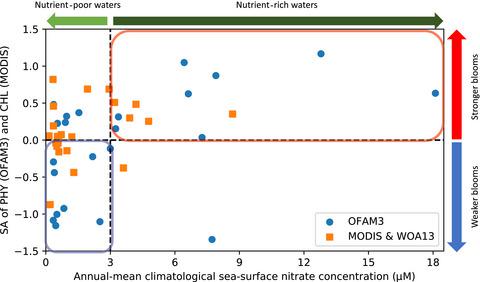当前位置:
X-MOL 学术
›
Glob. Change Biol.
›
论文详情
Our official English website, www.x-mol.net, welcomes your
feedback! (Note: you will need to create a separate account there.)
Background nutrient concentration determines phytoplankton bloom response to marine heatwaves.
Global Change Biology ( IF 10.8 ) Pub Date : 2020-06-25 , DOI: 10.1111/gcb.15255 Hakase Hayashida 1, 2 , Richard J Matear 2, 3 , Peter G Strutton 1, 2
Global Change Biology ( IF 10.8 ) Pub Date : 2020-06-25 , DOI: 10.1111/gcb.15255 Hakase Hayashida 1, 2 , Richard J Matear 2, 3 , Peter G Strutton 1, 2
Affiliation

|
Ocean temperature extreme events such as marine heatwaves are expected to intensify in coming decades due to anthropogenic global warming. Reported ecological and economic impacts of marine heatwaves include coral bleaching, local extinction of mangrove and kelp forests and elevated mortalities of invertebrates, fishes, seabirds and marine mammals. In contrast, little is known about the impacts of marine heatwaves on microbes that regulate biogeochemical processes in the ocean. Here we analyse the daily output of a near‐global ocean physical–biogeochemical model simulation to characterize the impacts of marine heatwaves on phytoplankton blooms in 23 tropical and temperate oceanographic regions from 1992 to 2014. The results reveal regionally coherent anomalies of shallower surface mixing layers and lower surface nitrate concentrations during marine heatwaves. These anomalies exert counteracting effects on phytoplankton growth through light and nutrient limitation. Consequently, the responses of phytoplankton blooms are mixed, but can be related to the background nutrient conditions of the study regions. The blooms are weaker during marine heatwaves in nutrient‐poor waters, whereas in nutrient‐rich waters, the heatwave blooms are stronger. The corresponding analyses of sea‐surface temperature, chlorophyll a and nitrate based on satellite observations and in situ climatology support this relationship between phytoplankton bloom anomalies and background nitrate concentration. Given that nutrient‐poor waters are projected to expand globally in the 21st century, this study suggests increased occurrence of weaker blooms during marine heatwaves in coming decades, with implications for higher trophic levels and biogeochemical cycling of key elements.
中文翻译:

背景养分浓度决定了浮游植物对海洋热浪的响应。
由于人为的全球变暖,海洋温度的极端事件,如海洋热浪,预计在未来几十年会加剧。据报道,海洋热浪对生态和经济的影响包括珊瑚褪色,红树林和海带森林的局部灭绝以及无脊椎动物,鱼类,海鸟和海洋哺乳动物的死亡率上升。相反,关于海洋热浪对调节海洋生物地球化学过程的微生物的影响知之甚少。在这里,我们分析了近全球海洋物理-生物地球化学模型模拟的日产量,以刻画1992年至2014年海洋热浪对23个热带和温带海洋学地区浮游植物开花的影响。结果揭示了海洋热浪期间较浅的表面混合层和较低的表面硝酸盐浓度的区域相干异常。这些异常通过光和养分限制对浮游植物的生长产生抵消作用。因此,浮游植物水华的反应是混杂的,但可能与研究区域的背景营养状况有关。在营养匮乏的水域中,海洋热浪期间水华较弱,而在营养丰富的水域中,热浪水华更强。海面温度,叶绿素的相应分析 但可能与研究区域的背景营养状况有关。在营养贫乏的水域中,海洋热浪期间水华较弱,而在营养丰富的水域中,热浪水华更强。海面温度,叶绿素的相应分析 但可能与研究区域的背景营养状况有关。在营养匮乏的水域中,海洋热浪期间水华较弱,而在营养丰富的水域中,热浪水华更强。海面温度,叶绿素的相应分析a和基于卫星观测值和原位气候的硝酸盐支持了浮游植物开花异常与背景硝酸盐浓度之间的这种关系。考虑到预计到21世纪全球营养贫乏水域将会扩大,这项研究表明在未来几十年的海洋热浪中,较弱水华的发生率会增加,这意味着较高的营养水平和关键元素的生物地球化学循环。
更新日期:2020-08-11
中文翻译:

背景养分浓度决定了浮游植物对海洋热浪的响应。
由于人为的全球变暖,海洋温度的极端事件,如海洋热浪,预计在未来几十年会加剧。据报道,海洋热浪对生态和经济的影响包括珊瑚褪色,红树林和海带森林的局部灭绝以及无脊椎动物,鱼类,海鸟和海洋哺乳动物的死亡率上升。相反,关于海洋热浪对调节海洋生物地球化学过程的微生物的影响知之甚少。在这里,我们分析了近全球海洋物理-生物地球化学模型模拟的日产量,以刻画1992年至2014年海洋热浪对23个热带和温带海洋学地区浮游植物开花的影响。结果揭示了海洋热浪期间较浅的表面混合层和较低的表面硝酸盐浓度的区域相干异常。这些异常通过光和养分限制对浮游植物的生长产生抵消作用。因此,浮游植物水华的反应是混杂的,但可能与研究区域的背景营养状况有关。在营养匮乏的水域中,海洋热浪期间水华较弱,而在营养丰富的水域中,热浪水华更强。海面温度,叶绿素的相应分析 但可能与研究区域的背景营养状况有关。在营养贫乏的水域中,海洋热浪期间水华较弱,而在营养丰富的水域中,热浪水华更强。海面温度,叶绿素的相应分析 但可能与研究区域的背景营养状况有关。在营养匮乏的水域中,海洋热浪期间水华较弱,而在营养丰富的水域中,热浪水华更强。海面温度,叶绿素的相应分析a和基于卫星观测值和原位气候的硝酸盐支持了浮游植物开花异常与背景硝酸盐浓度之间的这种关系。考虑到预计到21世纪全球营养贫乏水域将会扩大,这项研究表明在未来几十年的海洋热浪中,较弱水华的发生率会增加,这意味着较高的营养水平和关键元素的生物地球化学循环。











































 京公网安备 11010802027423号
京公网安备 11010802027423号